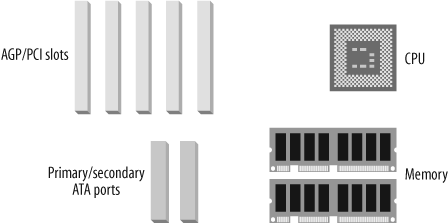I/O Channels
An I/O channel represents a single chain of devices attached to your machine, either internally or externally. Internal I/O channels are typically connected to a controller card (or to the motherboard) by ribbon cable. (Ribbon cables are flat cables, usually gray or blue, that interconnect hard drives and disk controllers inside a computer case.) Externally, you might connect drives or peripheral devices to a controller card using SCSI cables. The more identical, parallel I/O channels you have available for your array, the better performance you can expect out of it, as long as you are careful to identify and eliminate other bottlenecks.
The most common instance of parallel and identical I/O channels is the typical PC motherboard. Almost all i386-based motherboards include two onboard ATA/IDE disk controllers (see Figure 2-16).

When I say identical, I mean that each channel you select for use in your array supports the same architecture and protocols. Parallel means that each channel in the array can accept requests simultaneously. While you could theoretically use two different types of I/O channels in the same RAID array, you’d be wasting the performance of the faster channel because the faster chain needs to operate at slower rate in order to stay at the same pace as the other channels in the array. It’s generally not a ...
Get Managing RAID on Linux now with the O’Reilly learning platform.
O’Reilly members experience books, live events, courses curated by job role, and more from O’Reilly and nearly 200 top publishers.

